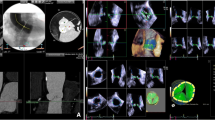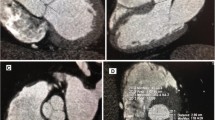Abstract
We aimed to evaluate the diagnostic performance of dual-source computed tomography coronary angiography (DSCT-CA) in the measurement of the ascending aorta (AA) diameter and compare the AA diameter in patients with severe bicuspid aortic valve (BAV) and tricuspid aortic valve (TAV) stenosis. Eighty-eight consecutive patients (50 men, mean age 60.3 ± 13 year) with severe aortic stenosis (AS) underwent DSCT-CA before aortic valve surgery. Seventy-four of the 88 patients underwent cardiovascular magnetic resonance (CMR). The internal diameter of AA was measured from early-systole with DSCT-CA and CMR by 2 radiologists independently at 4 levels (aortic annulus, sinuses of Valsalva, sinotubular junction, and tubular portion at the right pulmonary artery). The patients were divided in to 2 groups (BAV [n = 53]; TAV [n = 35]) according to operative findings. Patients with BAV were significantly younger than those with TAV (P = 0.0035). Inter-observer agreement of AA diameters at 4 levels with DSCT-CA and CMR was excellent (intraclass correlation coefficient = 0.89–0.97). Also, the DSCT-CA and CMR measurements of the AA diameter strongly correlated (r = 0.871–0.976). Mean diameter of the AA by DSCT-CA was significantly larger in patients with BAV (34.4 ± 8.2 mm) as compared to those with TAV (30.6 ± 5.5 mm). The diameters at the sinuses of Valsalva, sinotubular junction, and tubular portion were significantly larger in BAV than in TAV. Twenty-two of 53 (41.5%) patients with BAV and 2 of 35 (5.7%) patients with TAV had AA dilatation > 45 mm. DSCT-CA allows accurate assessment of the AA diameters in patients with severe AS. Patients with severe BAV stenosis had larger AA diameters and higher prevalence of AA dilatation > 45 mm as compared to those with severe TAV stenosis.




Similar content being viewed by others
Abbreviations
- AA:
-
Ascending aorta
- AR:
-
Aortic regurgitation
- AS:
-
Aortic stenosis
- AVA:
-
Aortic valve area
- BAV:
-
Bicuspid aortic valve
- CAD:
-
Coronary artery disease
- CMR:
-
Cardiovascular magnetic resonance
- DLP:
-
Dose-length product
- DSCT-CA:
-
Dual-source computed tomography coronary angiography
- ECG:
-
Electrocardiography
- HR:
-
Heart rate
- LV:
-
Left ventricular
- LVOT:
-
Left ventricular outflow tract
- MDCT:
-
Multidetector computed tomography
- TAV:
-
Tricuspid aortic valve
- TEE:
-
Transesophageal echocardiography
- TTE:
-
Transthoracic echocardiography
- VHD:
-
Valvular heart disease
References
Iung B, Baron G, Butchart EG et al (2003) A prospective survey of patients with valvular heart disease in Europe: the Euro Heart Survey on Valvular Heart Disease. Eur Heart J 24(13):1231–1243
Dare AJ, Veinot JP, Edwards WD et al (1993) New observations on the etiology of aortic valve disease: a surgical pathologic study of 236 cases from 1990. Hum Pathol 24(12):1330–1338
Ward C (2000) Clinical significance of the bicuspid aortic valve. Heart 83(1):81–85
Tadros TM, Klein MD, Shapira OM (2009) Ascending aortic dilatation associated with bicuspid aortic valve: pathophysiology, molecular biology, and clinical implications. Circulation 119(6):880–890
Roberts CS, Roberts WC (1991) Dissection of the aorta associated with congenital malformation of the aortic valve. J Am Coll Cardiol 17(3):712–716
Bonow RO, Carabello BA, Chatterjee K et al (2008) 2008 Focused update incorporated into the ACC/AHA 2006 guidelines for the management of patients with valvular heart disease: a report of the American College of Cardiology/American Heart Association Task Force on Practice Guidelines (Writing Committee to Revise the 1998 Guidelines for the Management of Patients With Valvular Heart Disease): endorsed by the Society of Cardiovascular Anesthesiologists, Society for Cardiovascular Angiography and Interventions, and Society of Thoracic Surgeons. Circulation 118(15):e523–e661
Schaefer BM, Lewin MB, Stout KK et al (2007) Usefulness of bicuspid aortic valve phenotype to predict elastic properties of the ascending aorta. Am J Cardiol 99(5):686–690
Nkomo VT, Enriquez-Sarano M, Ammash NM et al (2003) Bicuspid aortic valve associated with aortic dilatation: a community-based study. Arterioscler Thromb Vasc Biol 23(2):351–356
Della Corte A, Bancone C, Quarto C et al (2007) Predictors of ascending aortic dilatation with bicuspid aortic valve: a wide spectrum of disease expression. Eur J Cardiothorac Surg 31(3):397–405
Della Corte A, Romano G, Tizzano F et al (2006) Echocardiographic anatomy of ascending aorta dilatation: correlations with aortic valve morphology and function. Int J Cardiol 113(3):320–326
Tamborini G, Galli CA, Maltagliati A et al (2006) Comparison of feasibility and accuracy of transthoracic echocardiography versus computed tomography in patients with known ascending aortic aneurysm. Am J Cardiol 98(7):966–969
Debl K, Djavidani B, Buchner S et al (2009) Dilatation of the ascending aorta in bicuspid aortic valve disease: a magnetic resonance imaging study. Clin Res Cardiol 98(2):114–120
Gleeson TG, Mwangi I, Horgan SJ et al (2008) Steady-state free-precession (SSFP) cine MRI in distinguishing normal and bicuspid aortic valves. J Magn Reson Imaging 28(4):873–878
Caruthers SD, Lin SJ, Brown P et al (2003) Practical value of cardiac magnetic resonance imaging for clinical quantification of aortic valve stenosis: comparison with echocardiography. Circulation 108(18):2236–2243
Debl K, Djavidani B, Seitz J et al (2005) Planimetry of aortic valve area in aortic stenosis by magnetic resonance imaging. Invest Radiol 40(10):631–636
Ocak I, Lacomis JM, Deible CR et al (2009) The aortic root: comparison of measurements from ECG-gated CT angiography with transthoracic echocardiography. J Thorac Imaging 24(3):223–226
Li X, Tang L, Zhou L et al (2009) Aortic valves stenosis and regurgitation: assessment with dual source computed tomography. Int J Cardiovasc Imaging 25(6):591–600
Litmanovich D, Bankier AA, Cantin L et al (2009) CT and MRI in diseases of the aorta. AJR Am J Roentgenol 193(4):928–940
Tops LF, Wood DA, Delgado V et al (2008) Noninvasive evaluation of the aortic root with multislice computed tomography implications for transcatheter aortic valve replacement. JACC Cardiovasc Imaging 1(3):321–330
Morgan-Hughes GJ, Roobottom CA, Owens PE et al (2004) Dilatation of the aorta in pure, severe, bicuspid aortic valve stenosis. Am Heart J 147(4):736–740
Morin RL, Gerber TC, McCollough CH (2003) Radiation dose in computed tomography of the heart. Circulation 107(6):917–922
Hartnell GG (2001) Imaging of aortic aneurysms and dissection: CT and MRI. J Thorac Imaging 16(1):35–46
Joziasse IC, Vink A, Cramer MJ et al (2011) Bicuspid stenotic aortic valves: clinical characteristics and morphological assessment using MRI and echocardiography. Neth Heart J 19(3):119–125
Borger MA, Preston M, Ivanov J et al (2004) Should the ascending aorta be replaced more frequently in patients with bicuspid aortic valve disease? J Thorac Cardiovasc Surg 128(5):677–683
Hahn RT, Roman MJ, Mogtader AH et al (1992) Association of aortic dilation with regurgitant, stenotic and functionally normal bicuspid aortic valves. J Am Coll Cardiol 19(2):283–288
Keane MG, Wiegers SE, Plappert T et al (2000) Bicuspid aortic valves are associated with aortic dilatation out of proportion to coexistent valvular lesions. Circulation 102(19 Suppl 3):III35–III39
Ben-Dor I, Sagie A, Weisenberg D et al (2005) Comparison of diameter of ascending aorta in patients with severe aortic stenosis secondary to congenital versus degenerative versus rheumatic etiologies. Am J Cardiol 96(11):1549–1552
Stolzmann P, Scheffel H, Schertler T et al (2008) Radiation dose estimates in dual-source computed tomography coronary angiography. Eur Radiol 18(3):592–599
Acknowledgments
The authors would like to thank the CT and MR technologists, the Radiology department nursing staff, the Cardiology department staff physicians, and the residents in the Division of Thoracic Surgery at the Konkuk University Hospital. This paper was supported by Konkuk University in 2009.
Author information
Authors and Affiliations
Corresponding author
Rights and permissions
About this article
Cite this article
Son, J.Y., Ko, S.M., Choi, J.W. et al. Measurement of the ascending aorta diameter in patients with severe bicuspid and tricuspid aortic valve stenosis using dual-source computed tomography coronary angiography. Int J Cardiovasc Imaging 27 (Suppl 1), 61–71 (2011). https://doi.org/10.1007/s10554-011-9956-5
Received:
Accepted:
Published:
Issue Date:
DOI: https://doi.org/10.1007/s10554-011-9956-5




